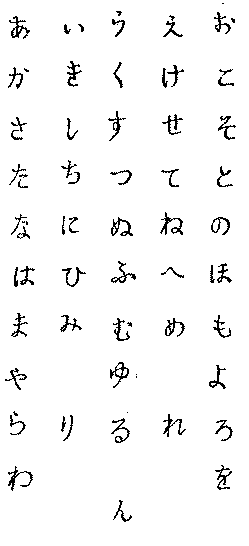

|
Japanese writing systems | |
| Lesson 10 | Translated from Russian by Alain Arkhipov |
Japanese is written in a combination of three scripts: hiragana, katakana and kanji. Kanji originated from Chinese characters. Hiragana and katakana developed from kanji to express Japanese syllables phonetically.
The Chinese characters were brought to the Japanese Islands in the end of the 3rd century (285 A.D.) by Korean pilgrims Wani and Ajiki. In that period of history the Chinese language and the Chinese characters were the privilege of well-educated people in Japan.
In 712 A.D. the oldest Japanese book "Konjiki", "The History of Ancient Events", was created. That book was written with the Chinese characters only. "Konjiki" consisted of many ancient Japanese songs in addition to numerous Japanese names and turns of speech. Obviously all those words had to be pronounced in Japanese. To write them down the Japanese used the Chinese characters ignoring their original meanings. The characters were used to represent Japanese syllables. Since that time the Japanese began to develop their own writing system where quite simple characters represent syllables only but not whole words. The result of this process is a Japanese syllabic alphabet known as "kana". There're two kinds of kana: Hiragana and Katakana.
The Japanese in contrast to the Europeans conceive words consisted of syllables, not letters. How will you read a word "CANADA" from right to left? I suppose it will be "ADANAC", isn't it? Japanese will say something like "DA-NA-CA".
| HIRAGANA You can write all Japanese words in hiragana. Besides, in Japanese newspapers you can see hiragana characters written near kanji characters which help people to read kanji. Japanese children start to read and write Japanese all in hiragana before making an attempt to learn some of the two thousand kanji currently used. |

|

|
KATAKANA As hiragana, katakana can be used to substitute kanji characters. Though katakana is used when writing down foreign names, places, and words of foreign origin. The structure of katakana is similar to hiragana (if you know one the other is easy to learn). The main difference between the two is katakana is composed of straight lines, where hiragana uses curved lines. |
| Exercise |
| Meet with hiragana on next page. Try to learn all hiragana characters by heart. You should be able to recognize them in any text and you should know how to write them. |
| Without understanding hiragana and katakana it will be difficult to you to continue learning Japanese. |

|
Copyright
© 2000-2003 A.M. Wurdow (Syktyvkar) http://www.komi.com/japanese |
|